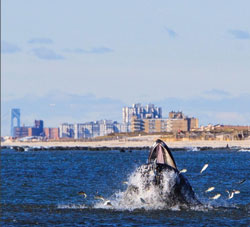The fall season brings cool water and lots of activity in the ocean. Falling water temperatures brings a great migration of fish that local fisheries and watermen have been catching for sport or bringing back to the dinner table.
There have been schools of blue fish, peanut bunker and stripe bass in our back yard. The University Bluffs has been the spot to find these “blitz” of fish that have been jumping out of the water.
Junior business student Pete Righi lives in the University Bluffs and is a member of the Monmouth University Football team. Righi said, “It’s crazy to look out your window and see the ocean. This past week I saw a whale that breached out of the water to feed off of the splashing fish around it.”
There have been many whale sightings off the coast of New Jersey that feed off of the pods of bunker for breakfast. Humpback Whales have been included in these sightings.
According to the Marine Mammal Stranding Center, it is common for humpback whales to feed off of the Jersey Shore. The center advises whale watchers to keep their distance from the large mammals, which are protected under the Marine Mammal Protection Act.
Assistant Dean Director of Marine and Environmental Biology John A. Tiedmann has arranged a study that tests striped bass that also feed off of the same bunker pods humpback whales search for. This study researches the physiology of captured angled stripe bass that are released back into the water. Tiedmann said, “With the support of the Berkeley Striper Club, this field study employs rapid assessment techniques designed to quantify physiology and post release behavioral responses of fish caught by various angling techniques and periods of air exposure.”
The Berkeley Striper Club will meet at Island Beach State Park on Friday Dec. 2 and Saturday Dec. 3.
Researchers and student members of the club will catch fish with equipment funded by the Berkeley Striper Club and test for levels of plasma lactate, glucose and pH.
The stress levels will be calculated with the help of NOAA James J. Howard Sandy Hook Marine Lab. The team will utilize their 32,000 gallon saltwater tank to study post-release angled striped bass physiology and behavior.
There are many ways to catch striped bass. You can get lucky and use clam bellies that sit on the bottom of the ocean, or surf cast floating treble hooks on the top of the ocean that mimic distressed blue fish.
Angling methods use jigs to disturb the oceans surface and attract striped bass. The legal limit to catch and keep striped bass is 28 inches for one fish. If you keep 2, the second one has to be larger than 48 inches.
This is measured from the tip of the snout to the end of the tail.
Senior health education student and Monmouth Lacrosse player Dylan Schulte has been catching these striped bass in between practice and his studies. He disclosed this tip “You have to look for the birds! If you see birds circling an area then you know the fish are underneath.”
Photo Courtesy of Hunter Rainis



